May 5, 2020 — A graph showing the number of deaths from or with the SARS-CoV-2 virus per million population per country places Croatia among the five best-ranked countries with the lowest proportional death toll, according to the Johns Hopkins University Coronavirus Database.
In addition to Croatia, there are Greece, Poland, Bulgaria and – according to the available data – Slovakia. The next low mortality group includes the Czech Republic, Hungary, Finland, Romania, Estonia, Norway, and Slovenia, with the worst situation affecting Belgium, Spain, Italy, and France.
Compared to Croatia, often due to its access to epidemic measures, oft-mentioned Sweden has a death toll of around 14 times per million. Belgium has as many as 35 times more casualties per million inhabitants.
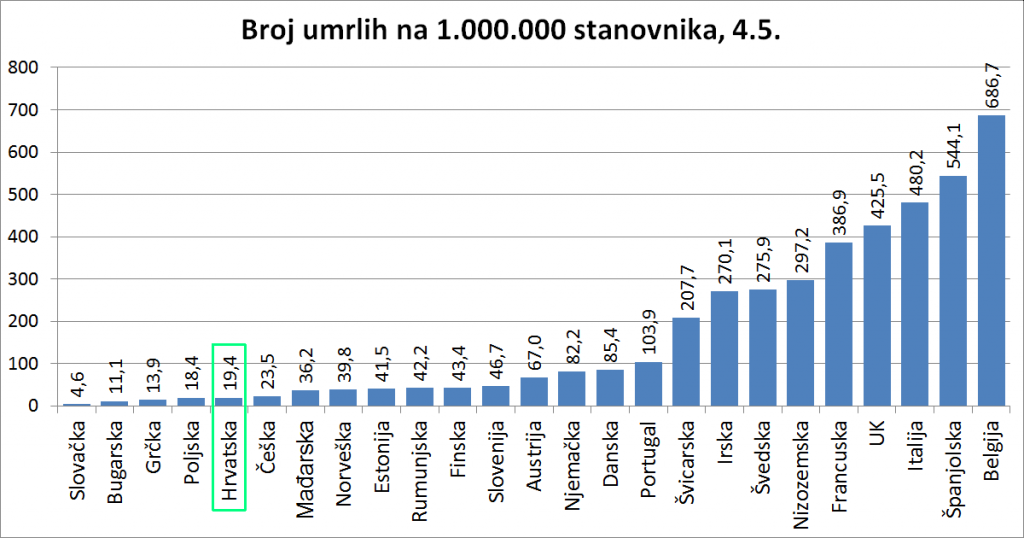
Specifying only the absolute numbers of registered infected persons or persons who died from or with the presence of a new coronavirus per country does not give a true picture of the situation, given that there are huge differences in the populations of individual states.
For example, Belgium with its 11.5 million inhabitants has so far had 7,924 casualties, while Italy with 60.5 million inhabitants has 29,079 casualties, but Belgium has as much as 43% more casualties per million inhabitants than Italy.
It can also be said that Germany with 6,866 deaths has far more casualties than Sweden with 2,769, and in fact, per million inhabitants Germany has 70% fewer casualties than Sweden.
When looking at the number of infected persons and their outcomes starting on the same day, regardless of the outbreak of the epidemic in each country, as shown in the following figure, it is difficult to compare the epidemic development by country in parallel. The slope of a single curve over a period indicates the rate of spread of the epidemic, as far as can be determined by confirmed infections. We do not know the number of undiagnosed infected people.
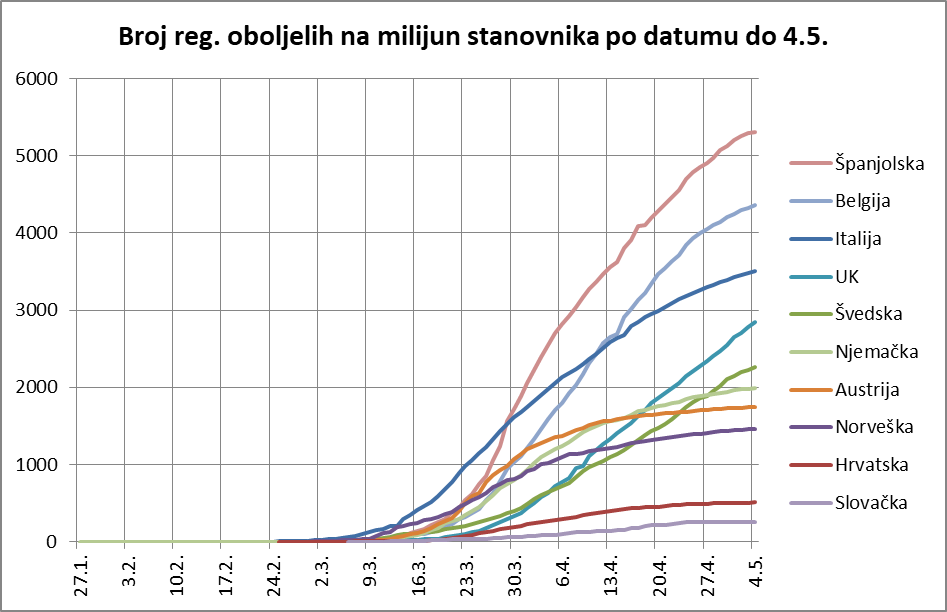
It can be seen that among the observed countries, the epidemic first flared up in Italy. However, the increase in the number of patients in Spain (about a week later) was much faster than in Italy, and the number of people in Italy had increased by one million people by the end of March.
Spain has the highest number of patients per million people in the countries, and the curve is just beginning to show a significant reduction.
The second-fastest growing epidemic is Belgium, with a slightly lower growth rate than Spain, also with indications the virus’s spread is slowing in the past week.
Italy, the third-most infected country in terms of numbers per million people, has been showing signs of slowing down over the past two weeks.
The next two countries that currently have linear curves with no signs of slowing down are the United Kingdom and Sweden. Sweden exceeded the number of registered patients per million inhabitants in Germany in early May, and their own research indicates the likelihood of a large proportion of residents infected but not diagnosed.
Slovakia and Croatia have controlled the epidemic well from the outset, and Austria, Norway, and Germany have been able to successfully cope with the rapid growth that occurred around the week of March 23-30.
The following chart provides an overview that begins for each country from the date the infected person was first registered in that country. In this way, it is possible to compare the development and effects of epidemic suppression both in dynamics and in relative numbers per million population.
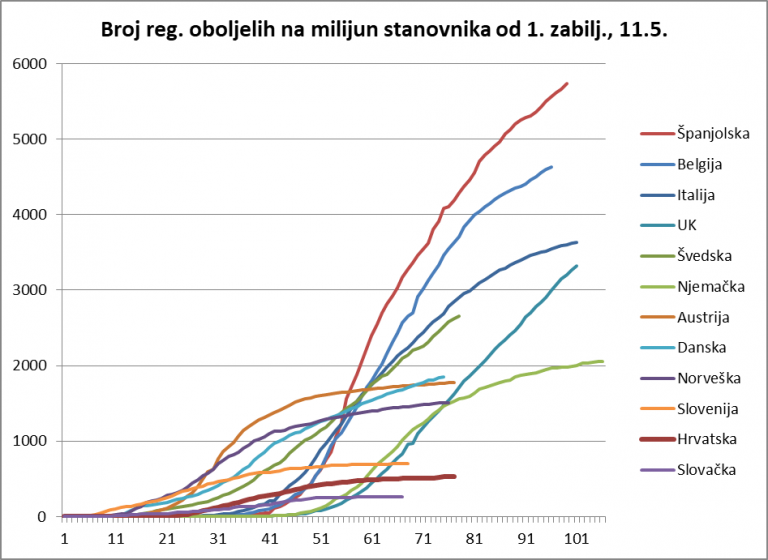
At first glance, two groups stand out from the countries observed. The left group is one in which the epidemic developed relatively quickly after the first diagnosed person in terms of population: Austria, Norway, Denmark, Sweden, Croatia, and Slovakia. Of course, these are smaller countries. The right group is one in which more time has elapsed since the emergence of the first infected person (that is, the first infected person was diagnosed much earlier) and they are in the order of the state with a larger population.
In the first group, there was a rapid increase in the number of people infected in Austria, but also a very rapid response that reversed the epidemic as early as the 32nd day, and even without “leveling”, a consistent reduction in the number of new infections was immediately achieved.
The epidemic has calmed down after about 50 days in that country, which of course has a great impact on deciding what to do next. The rate of increase in the number of people infected since week 51 is actually the same as in Croatia, except that there are significantly fewer patients in Croatia.
There is a similar course to the epidemic in Norway, with an even sharper start, but apparently a swift response from the authorities, who reversed the trend around day 32 as well, and contained the epidemic around day 45.
In Denmark, the epidemic started very much like in Norway, with the first calming down even faster, but after that linear growth continued at a rate higher than in Austria and Norway.
The same group is followed by Sweden, which initially did not have rapid growth, but around the 55th day grew in the number of registered infected persons Denmark, Norway, and Austria, and around the 66th day also Germany, and does not see any calm.
Viewed from this chart, Croatia and Slovakia maintain a very low slope linear curve from the very beginning and have the lowest number of registered infected persons per million inhabitants.
The group of larger countries shows that the worst situation is in Spain, which after exponential growth until the 56th day of the epidemic in its territory, was able to achieve linear growth in its curve, and then from around the 62nd day a slightly milder but still large slope. Within a few days, it could be felt that the epidemic was beginning to subside.
It is similar in Belgium, which flattened the curve around day 54, but has since maintained a steady but high (relative) increase in new infections with signs of calming back for several days.
Italy, whose exponential curve started about a week before the one in Spain, reached a more moderate slope of the linear part of the curve around day 49 and shows a slight calming of the epidemic after about 81 days.
Germany, with some time lag compared to the first registered infected person, achieved a curve similar to Austria, with a trend change around day 68. But its rate of increase in the number of infected in the back of the curve is still higher than in Austria.
After exponential growth, the UK was able to straighten the curve around day 70, but with no indication of stabilization.
Looking more closely at Sweden, we can see a form of exponential growth in the number of infected people that has turned linear over the last three weeks.
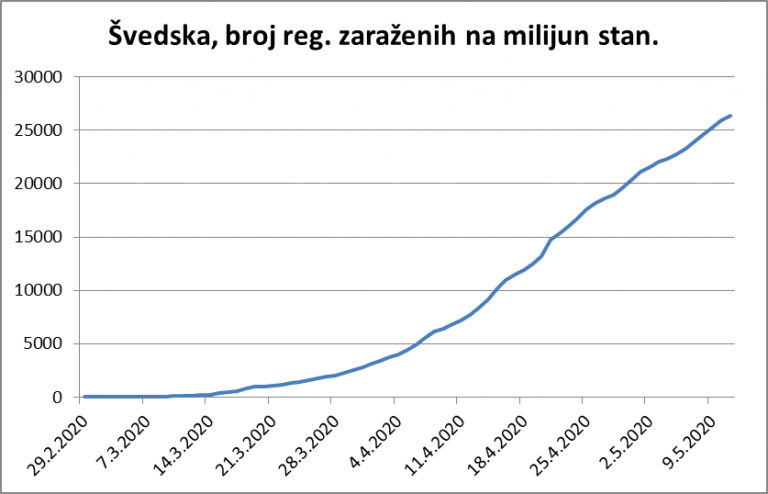
If we take a closer look at Croatia, we will see that linear growth has already been achieved around March 22 (just after the earthquake in Zagreb), and from April 16 is very successful in calming the epidemic. It could also be statistically concluded that the average healing time for registered patients is between three and three-and-a-half weeks.
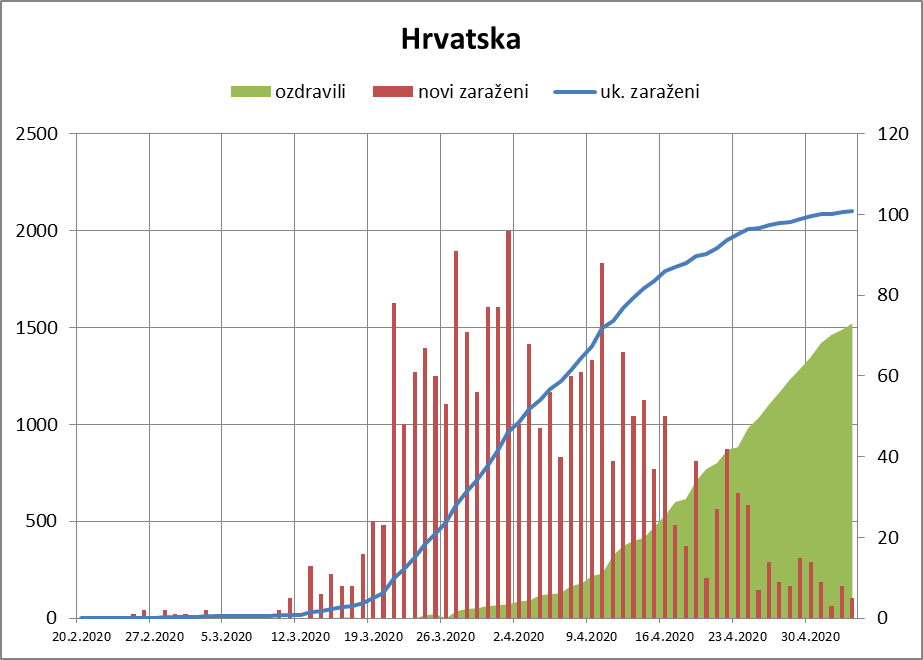
Croatia’s excellent result can also be seen in the chart showing the trend in the number of sick and dead.
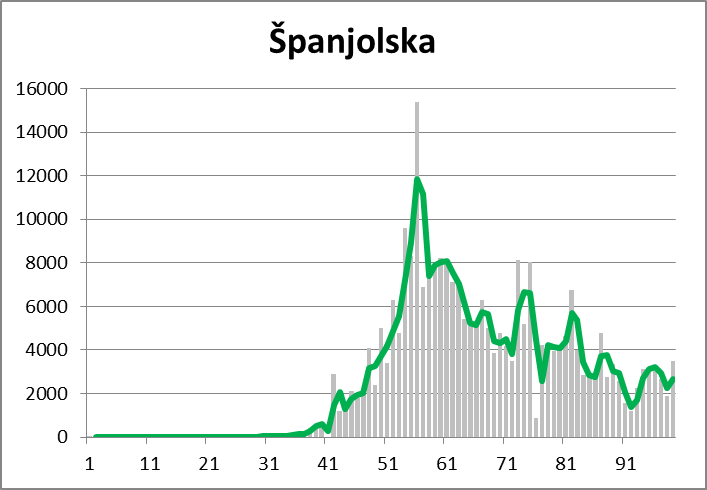
These topics often raise the question of what is a good test measure and whether we are testing enough. An excellent graphical representation of the testing ratio per million population and the percentage of positives shows who optimally tests and who does not. If you are about 10% positive you have found a good measure – Croatia is.
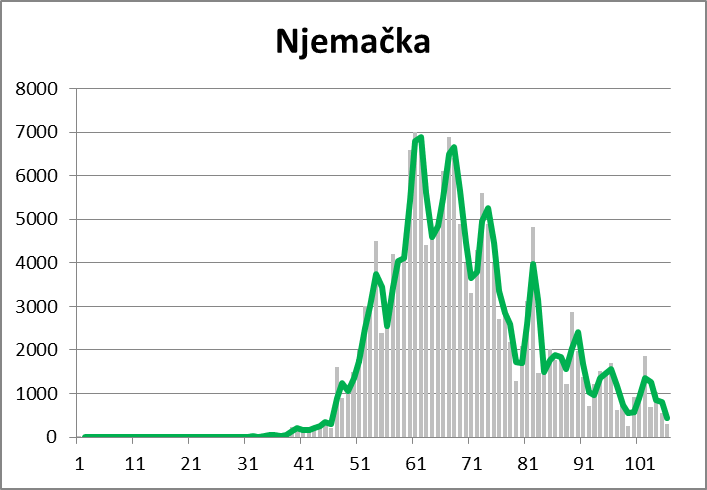
It can be concluded that the epidemiologists were in excellent control of the epidemic and that the Civil Protection Directorate made successful recommendations and measures to mitigate it.
Scientific knowledge, in comparison to the usual political ones, is neither conservative nor radical; they are simply as they are and should be trusted. And so others reasonably rank Croatia among the countries that successfully defeated the coronavirus.
Given that crisis management decisions, especially in the phase of loosening anti-epidemiological measures, are not exclusively health but equally political, further careful monitoring of the situation and comparison with policy decisions and health outcomes in other countries is needed.
Of course, every country can be asked what its long-term perspective is in these new circumstances that will not go away.
Countries that have curbed the epidemic in the sense that they have ensured that their health care system can control the situation, may be far more comfortable developing a further strategy than those who still have to put all their efforts into maintaining the health system’s functionality.
And finally – is coronavirus more dangerous than the flu? Yes, but as far as we may know, in just a few months, we are learning something new every day. The important difference is that the behavior of SARS-CoV-2 is still a great unknown and that we do not have vaccines or reliable treatment for severe forms of COVID-19.







